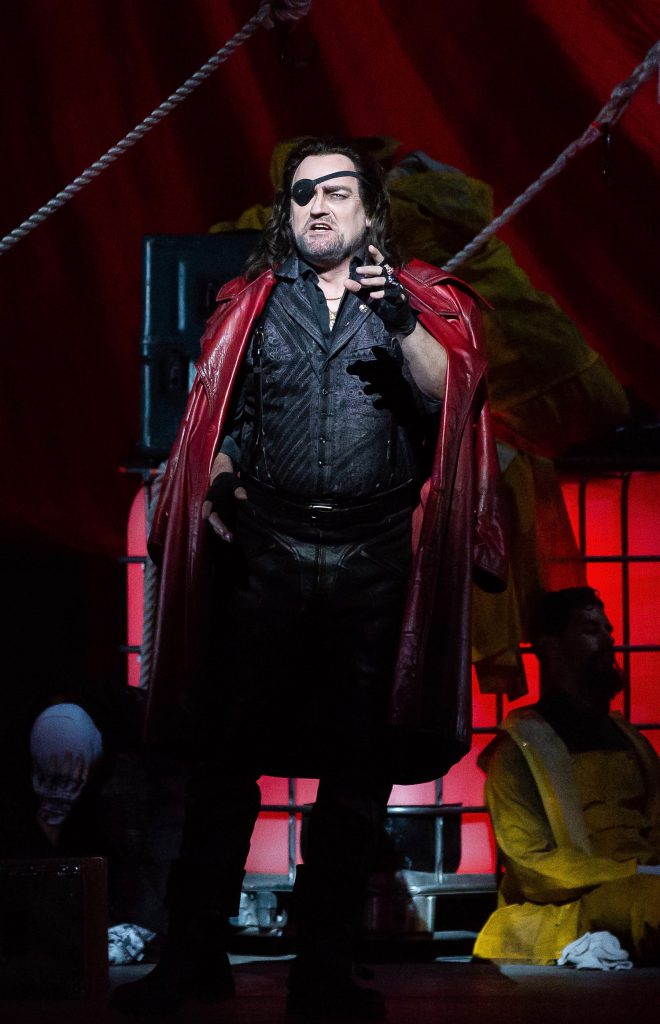Houston Grand Opera’s dramatic “Dutchman” makes a worthy homecoming

Andrzej Dobber stars in Wagner’s “The Flying Dutchman” at Houston Grand Opera. Photo: Lynn Lane
A year after a storm drove Houston Grand Opera from its home, a second storm ushered the company back.
Hurricane Harvey’s deluge last August inundated the Wortham Theater Center, and the extended repair work forced HGO to perform an entire season in a makeshift setup at the George R. Brown Convention Center. On Friday night, the orchestral torrent that launches Richard Wagner’s The Flying Dutchman propelled the company—rather like Daland’s homesick sailors—back into the company’s familiar hall.
The most arresting part of director Tomer Zvulun’s production may have been the video that added to the explosive tumult of Wagner’s overture. Designed by S. Katy Tucker, it flooded the proscenium scrim with abstract expressionist strokes—suggestions of inky water flung through space, clouds churning in the wind, and sails buffeted by gales. Washes of scarlet hinted not only at the blood-red sails Senta envisions on the Dutchman’s ship, but at the hellish forces that doom the opera’s antihero to sail the seas in search of redemption.
When all that subsided, Zvulun and set designer Jacob A. Climer sidestepped the traditional settings. Their Dutchman included no Norwegian seacoast and no ships reaching shore. Rather, the action unfolded in front of a towering semicircular wall, a gray expanse that suggested a factory—literally so in the scene with Senta and the other village women, who worked at sewing machines making sails. The hampers that held their fabric served other purposes elsewhere: They became platforms that evoked the decks of Daland’s ship, and later, tables for the sailors’ welcome-home party.
Most powerfully, the capacious wall doubled as a screen for more of Tucker’s projections. Even though parts of the set–such as the women’s sewing machines–suggested the early 20th century, the projections kept the emphasis on the fantastical. Apparitions of the Dutchman’s ghostly sailors sometimes appeared on it, creating a spookiness more novel than a traditional production with a ship. At the opera’s climax, as the Dutchman revealed his identity, the wall became an expanse of water, showing what awaited the accursed seafarer if Senta forsook him.
But when Senta finally proclaimed her faithfulness, soprano Melody Moore’s brilliant tones—especially her laser-focused top notes—signaled that the heroine’s resolve would never flag.
Moore’s commanding voice and compelling presence established Senta as the real driving force of this opera. Within moments of Moore’s appearance, she sang the rugged opening of Senta’s Ballad with strength and security. Yet when the text and music turned toward the Dutchman’s redemption, Moore’s gentleness showed that Senta already felt compassion for a man she knew only as a legend.
In Senta’s scenes with the Dutchman and with her would-be suitor Erik, Moore gave the demeanor of a woman constantly reaching out, literally and figuratively, in search of understanding and connection. (She also sang Senta’s blazing final declarations after climbing a ladder, in full view of the audience, to a window ledge on the set’s third level.)
As the Dutchman, baritone Andrzej Dobber didn’t quite match Moore’s urgency, with a voice that was sturdy rather than voluminous. The difference became clear during the Dutchman’s scene with Daland, Senta’s father: Bass Kristinn Sigmundsson brought the big moments a booming power that Dobber lacked.
The torment and somberness of the Dutchman’s monologue may not have generated Wagner-scale electricity, but as the duet with Senta began, Dobber’s long-breathed singing, full of evocative half-tones, revealed the wonderment and hope stirring within the Dutchman. In the opera’s final moments, Dobber got a literal boost from standing on a platform one level above the stage: The Dutchman’s last proclamations rang out with more impact than anything that came before.
A powerful Daland, Sigmundsson was also capable of lighter moments, like his affection for his daughter—and his delight in finding her a rich husband.
Tenor Eric Cutler, as the jilted Erik, boasted a voice with ring and security. He sometimes left those behind, though, singing with such quivering agitation and shrieking excitement that Erik resembled a desperate Italian-verismo protagonist on the brink of bloodshed.
Tenor Richard Trey Smagur, a member of the HGO Studio training program, delivered the Steersman’s aria with ring and spirit, plus a dash of tenderness when the topic turned to the sweetheart waiting at home. As his fellow sailors, the men of the HGO Chorus were a full-throated lot, and the women brought a perky lightness to the Spinning Chorus. And when the full-strength group launched into the confrontation with the Dutchman’s crew, they created as much sonic excitement as any of the principals.
The performance used Wagner’s original, no-intermission version of the score. Patrick Summers, HGO’s artistic and music director, paced the music with a dynamism that revealed the cumulative power of taking Dutchman in one fell swoop. While the HGO Orchestra may not have commanded the dark, weighty tones of some ensembles, its leanness and vitality helped capture the music’s turbulence, drama and occasional brightness.
When the performance ended, rain was again falling outside the theater. But this time, Mother Nature didn’t unleash a flood.
The Flying Dutchman runs through Nov. 2 in Houston’s Wortham Theater Center. houstongrandopera.org; 713-228-6737.